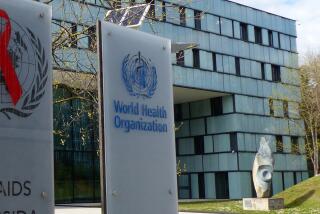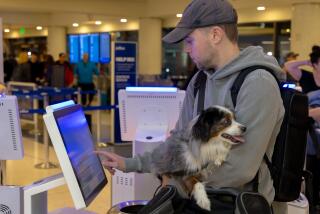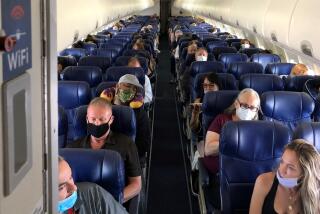Airplanes’ air may be clean, but what about cabin surfaces?
- Share via
Government studies have debunked the long-held myth that air circulated in commercial planes is jampacked with disease-causing germs.
Now comes a study that raises fears about germs on cabin surfaces.
Microbiologists and engineers at Auburn University found that disease-causing bacteria can live several days on armrests, tray tables, toilet buttons, window shades, seat pockets and seat leather.
The bacteria tested in the study include a type of E. coli that can cause diarrhea in adults and a drug-resistant Staphylococcus that can lead to infections, skin disease, pneumonia and sepsis.
Bacteria in saliva that researchers placed on seat pockets lived the longest — eight days, according to the study, sponsored by the Federal Aviation Administration.
The airline industry points out that their cabins are routinely cleaned.
“Airlines know that cleanliness of aircraft is important to customers when they make their travel decisions,” said Jean Medina, a spokeswoman for Airlines for America, the trade group for the nation’s largest airlines. “As such, airlines work continuously to keep planes clean.”
You can at least breathe easier that the U.S. Centers for Disease Control has already dismissed fears about diseases spread by air on commercial planes.
Newer planes recirculate up to half of cabin air with outside air and pass it through a series of high-efficiency particulate air (HEPA) filters, up to 30 times per hour, according to the CDC.
“As a result, the air cabin environment is not conducive to the spread of most infectious diseases,” the agency says.
Body scanners removed from airports go to jails, government agencies
Responding to privacy concerns raised by travelers and civil rights groups, the Transportation Security Administration pulled 171 full-body scanners from airports last year.
But the scanners, which cost between $130,000 and $170,000 each, have not gone to waste.
Most have been shipped to jails, prisons and state and local government agencies.
The TSA reported that 154 of the scanners were recently transferred to law enforcement agencies in Arkansas, New York, Michigan and other places, with 96 others remaining at the manufacturer’s warehouse.
Several law enforcement agencies paid only a fraction of the original cost under a federal surplus program.
The TSA stopped using the scanners in 2013 because the manufacturer failed to add software to protect the privacy of passengers. The scanners created what resembled a nude image to detect hidden objects under passengers’ clothes.
The TSA now uses a different type of full-body scanner that alerts screeners about possible hidden weapons by showing yellow boxes on a picture of a generic, cartoon-like image.
Hotel guests warming to water-conservation efforts
When hotels ask guests to reuse towels to conserve water and energy, about half of guests say they comply, with another 39% saying they sometimes reuse towels.
Those results, from a survey of 2,700 travelers nationwide, suggest most travelers have accepted some conservation efforts by the hotel industry, said Patricia Griffin, president and founder of the “Green” Hotels Assn., a global environmental group.
“It is the one thing across the board that hotels are doing to conserve,” she said.
The survey found that 11% of guests ignore conservation efforts and instead throw used towels on the floor, according to the survey by Travel Leaders Group, a Minneapolis travel company.
Still, Griffin said travelers and hotel owners have made much progress in conserving water and energy since hotels began in the early 1990s to urge guests to reuse towels.
Business travelers and college students are most likely to reuse towels, she said.
Who is least likely?
“It’s mostly families on vacation,” Griffin said. “They just throw towels all around.”
More to Read
Inside the business of entertainment
The Wide Shot brings you news, analysis and insights on everything from streaming wars to production — and what it all means for the future.
You may occasionally receive promotional content from the Los Angeles Times.











